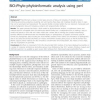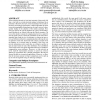920 search results - page 177 / 184 » Object Recognition from Large Structural Libraries |
BMCBI
2011
13 years 2 months ago
2011
Background: Phyloinformatic analyses involve large amounts of data and metadata of complex structure. Collecting, processing, analyzing, visualizing and summarizing these data and...
EDBT
2010
ACM
14 years 1 months ago
2010
ACM
When selecting alternatives from large amounts of data, trade-offs play a vital role in everyday decision making. In databases this is primarily reflected by the top-k retrieval p...
ECCB
2005
IEEE
14 years 19 days ago
2005
IEEE
Many areas of modern biology are concerned with the management, storage, visualization, comparison, and analysis of networks. For instance, networks are used to model signal trans...
SSDBM
2005
IEEE
14 years 18 days ago
2005
IEEE
Data products generated from remotely-sensed, geospatial imagery (RSI) used in emerging areas, such as global climatology, environmental monitoring, land use, and disaster managem...
CP
2003
Springer
14 years 7 days ago
2003
Springer
Multiple sequence alignment is a central problem in Bioinformatics. A known integer programming approach is to apply branch-and-cut to exponentially large graph-theoretic models. T...


